St
Stephen’s Anglican Church
Church Street, Richmond
Built 1865 J.W. Walker, London for 'Rose Hill', Toorak
Installed present location 1869
Restored 1963 Arthur Jones for J.W. Walker & Sons Ltd
Restored 2018-2019 Wakeley Pipe Organs Pty Ltd
3 manuals, 29 speaking stops, 5 couplers, mechanical action
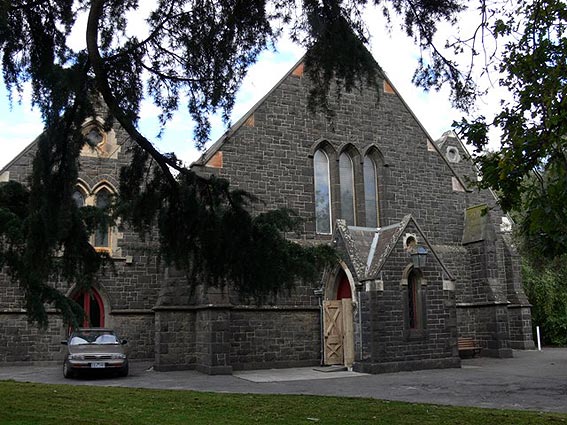
St Stephen's Anglican Church, Richmond: exterior from the west
[photograph by John Maidment (13 April 2006)]
Historical and Technical Documentation by John Maidment
© OHTA, 2006 (last updated January 2020)
St Stephen’s Parish, which dates from 1849, was the first to be
established in the eastern suburban area. An acre of land was offered
in this year by the Revd Joseph Docker, a local landowner, after whom
Docker’s Hill was named, and by the end of the year Arthur Newson and
James Blackburn had been engaged to design a church building. The
foundation stone was laid in June 1850 and the unfinished church
opened in November 1851. Further work, mainly on the interior, was
carried out in 1854 under the supervision of architect Charles Webb.
In 1863 the north aisle was erected to the design of Nathaniel
Billing, and the west wall of the church rebuilt. In 1876 the south
aisle and chancel were erected under the supervision of architect D.
Goldie while in 1923 the choir vestry was erected by Clements
Langford, thus completing the fabric of the building as it stands
today.
At one stage, Robert Speechly, a pupil of English architect Gilbert
Scott, produced a fine design for the south aisle, chancel and a tower
and spire, in the idiom of English architect G.E. Street, to be placed
at the western end of the south aisle, while at a later stage, D.
Goldie designed a tower and spire to be placed at the north-east end
of the building, adjacent to the sanctuary, neither of which were
built.
There are other substantial church buildings on the site, including
the massive Jubilee Hall and School Hall some dating back to 1857.
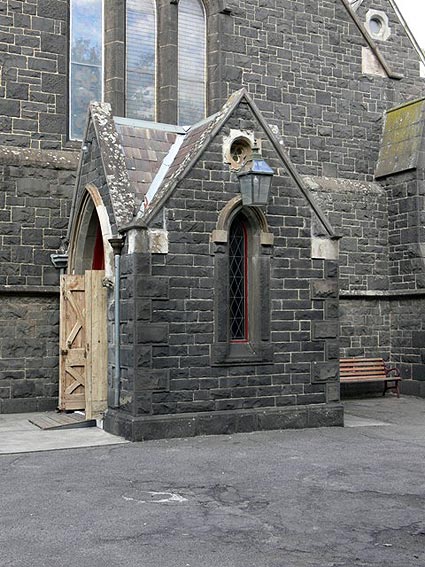
St Stephen's Anglican Church, Richmond: western porch
[photograph by John Maidment (13 April 2006)]
St Stephen’s is built in bluestone and comprises a nave of five bays,
with wide flanking aisles (originally filled with galleries), chancel
and vestries. The interior was refurbished in the 1980s, with the
removal of many pews, overall carpetting, and installation of chairs.
The original chancel, however, remains intact, with its choir stalls,
tesellated tiled floor, wall decorations and altar furnishings.
The church contains important stained glass by prominent local firms including the east and west windows, by Ferguson & Urie, of North Melbourne, by Brooks, Robinson in the aisles, and an unusual window at the west end of the south aisle 'Noli me Tangere', one of the very few known examples of the work of August Fischer, who worked in Melbourne from 1893-1910. There are several modern windows in the aisles, one including references to the pioneering Docker family.
The most significant object in the interior is the three-manual pipe organ built in 1865 by the noted London organbuilder Joseph Walker at a cost of £650 for the music room of 'Rose Hill', a large residence near the corner of Glenferrie & Toorak Roads, Toorak, owned by William Philpott, the firm’s job number 776. In 1869 the organ was sold to St Stephen's replacing an earlier organ by Bevington of London which is thought to have ended up at St Matthias' Church in North Richmond, and was broken up for parts in 1971.
The instrument is notable for its solidity of construction and the lavish use of materials. The casework and console fittings are of oak while all of the metal pipework is of spotted metal. The provision of upperwork is very generous, with 14 ranks above 4ft pitch.
The Walker organ remains substantially intact (apart from the addition of a few stops to the Choir Organ) in part due to the vigilant attitude of the organist of the 1960s and 70s Bruce Evans; it is considered to be of international significance for its size and level of originality. It has an oak case, with spotted metal façade pipes, and an attached console, retaining the original keyboards and drawstops. Its tonal quality and range is outstanding.
The instrument is notable for its solidity of construction and the lavish use of materials. The casework and console fittings are of oak while all of the metal pipework is of spotted metal. The provision of upperwork is very generous, with 14 ranks above 4ft pitch.
Minor restoration was carried out in 1963 by Arthur Jones for J.W. Walker & Sons Ltd, but the scope of this work was limited and largely consisted of work on the mechanical actions and the fitting of tuning slides.
In recent years, the organ had become increasingly
difficult to play in summer months, with the swell action impossibly
heavy. The wind reservoir was close to collapse, still retaining its
leather from the 1860s. Much of the pipework was out of regulation owing
to the poor condition, particularly leakage and runnings, of the
windchests. Moreover, the position of the organ was unfortunate, the
sound broken up by a low arch and only about two-thirds of the front
case visible.
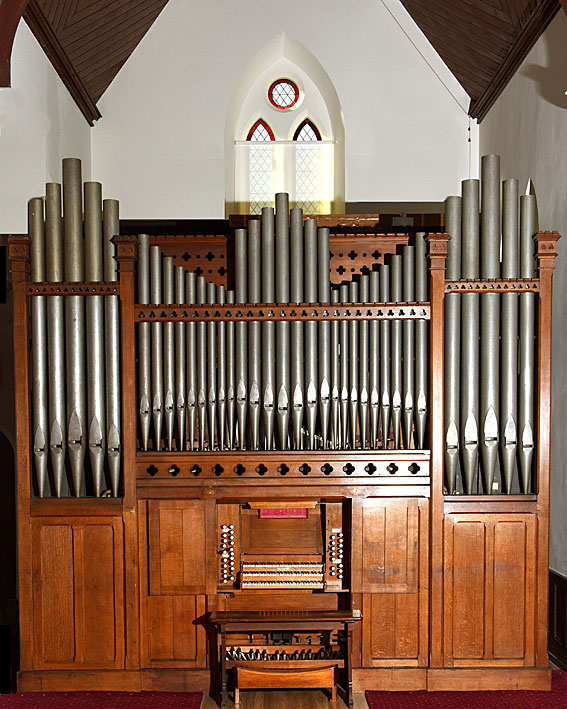
St Stephen's Church, Richmond - restored organ case and façade
(photograph by Barrie Bell [September 2019])
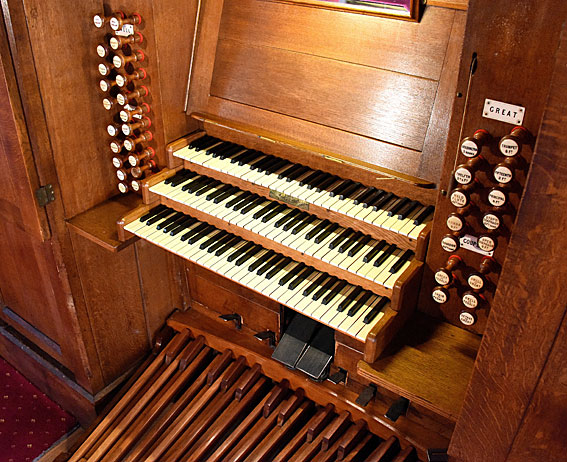
St Stephen's Church, Richmond - restored console
(photograph by Barrie Bell [September 2019])
The most recent extensive restoration, in 2018-2019, has been carried out by Wakeley Pipe Organs Pty Ltd, of Bayswater, Victoria and funded by an OHTA appeal. The Organ Historical Trust of Australia is listed on the Federal Government's Register of Cultural Organizations (ROCO) and can grant tax-deductibility to fund raising projects for approved organ restorations. The appeal target was $325,000 and the appeal has been highly successful, attracting a number of major donations. John Maidment OAM has acted as consultant for the work which has been carried out under the supervision of Heritage Victoria, with whom the instrument is registered.
The current work has included:
• Complete dismantling of the organ and removal to the organbuilder's workshop
• Releathering of the large double-rise reservoir and feeders and hand-blowing facility
• Restoration of the manual and pedal slider chests, involving the planing down and levelling of the tables, refitting of sliders and releathering of pallets
• Complete overhaul of the manual and pedal coupling actions and roller boards
• Minor restoration to the console, replacement of felt drawstop ferrules, overhaul of keyboards and pedal board
• Minor repairs to metal pipework including removal of the later Fincham dust bonnets placed on the Great Trumpet (these served to stifle the sound) and small extensions to the pipes to restore original lengths
• Repairs to wooden pipework, particularly addressing splits and cracks in the larger pipes
• Repairs to the left hand side of the oak case panelling, cut away when the Choir box was added and reconstruction of missing timber in figured oak to match up with the left side of the Choir swell box which is now visible
• Construction of a raised tuning platform to enable the rear pipes of the Choir Organ to be tuned safely
• Rotation of the organ through 90 degrees to face down the aisle and placement at floor level to provide a greatly enhanced visual and acoustical result
Restoration of the slider windchests has had a dramatic effect upon pipe speech and voicing. Some of the manual fluework had been re-regulated to cope with winding irregularities, but all is now speaking at its correct pressure and tonal quality.
The mechanical action is now working much more freely as a result of the work. It had become severely misaligned owing to movement in the organ's framing. The Great octave coupler may now be used with ease.
All of the original timber finishes have been preserved and no repainting of surfaces has taken place, in line with current conservation best practice.
The appearance and sound of the organ has been greatly enhanced through its rotation to face down the south aisle. The whole of the case is now visible and the sound is no longer trapped under a low arch. With 14 ranks of upperwork, the sound is extraordinarily brilliant and the Mixtures have only unison and quint partials.
| GREAT Bourdon Open Diapason Gamba Stop’d Diapason Principal Wald Flute Twelfth Fifteenth Sesquialtra Trumpet Swell to Great Octave to Great SWELL Bourdon Open Diapason Stop’d Diapason Principal Piccolo Twelfth & Fifteenth Mixture Cornopean Oboe Tremulant CHOIR Keraulophon Flute Harmonique Stop’d Diapason Dulciana Vox Angelica Concert Flute Flageolet Clarionet Tremulant PEDAL Open Diapason Bourdon Great to Pedals Swell to Pedals Choir to Pedals |
16ft tone 8ft 8ft 8ft tone 4ft 4ft tone 2-2/3ft 2ft 3 ranks 8ft 16ft tone 8ft 8ft tone 4ft 2ft 2-2/3 & 2ft 5 ranks 8ft 8ft 8ft 8ft tone 8ft tone 8ft 8ft 4ft tone 2ft 8ft 16ft 16ft tone |
15.19.22 15.19.22.26.29 (enclosed 1908) TC Fincham 1890 TC Fincham 1908 Walker 1963, harmonic TC Fincham 1890 |
Compass: 56/30
Mechanical action to keys and stops
Balanced mechanical swell pedals (later alteration)
6 composition pedals
St Stephen's Richmond 1988 [booklet]
Victorian Churches: their origins, their story & their architecture, edited by Miles Lewis. Melbourne: National Trust of Australia (Victoria), 1991
Robert Owen White, Lawrence John Wilson. St. Stephen's Church of England Richmond. ([History IV] 1967 research essay, University of Melbourne, Faculty of Architecture, Building & Planning)
Notes prepared for a Melbourne Autumn Music Festival function 'Historic Churches & Organs of Richmond', Saturday 3 May 2003 compiled by John Maidment
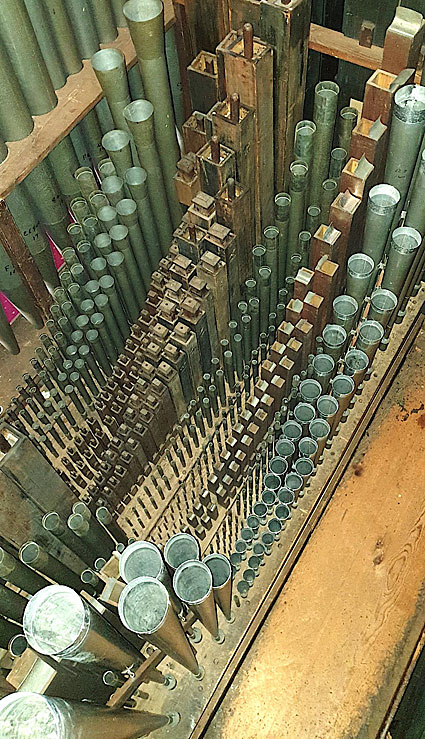
St Stephen's Church, Richmond - restored Great pipework
(photograph by Ian Wakeley [November 2019])
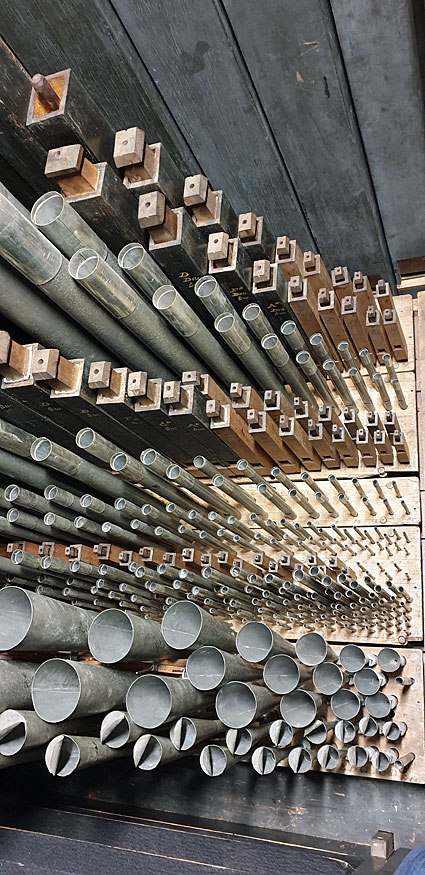
St Stephen's Church, Richmond - restored Swell pipework
(photograph by Ian Wakeley [November 2019])
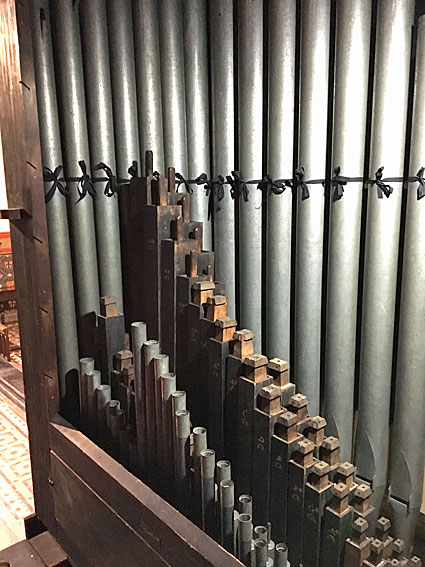
St Stephen's Church, Richmond - restored Choir pipework
(photograph by John Maidment [November 2019])
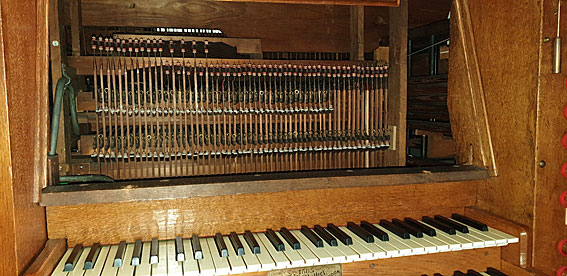
St Stephen's Church, Richmond – coupling action mechanism
(photograph by Ian Wakeley [November 2019])
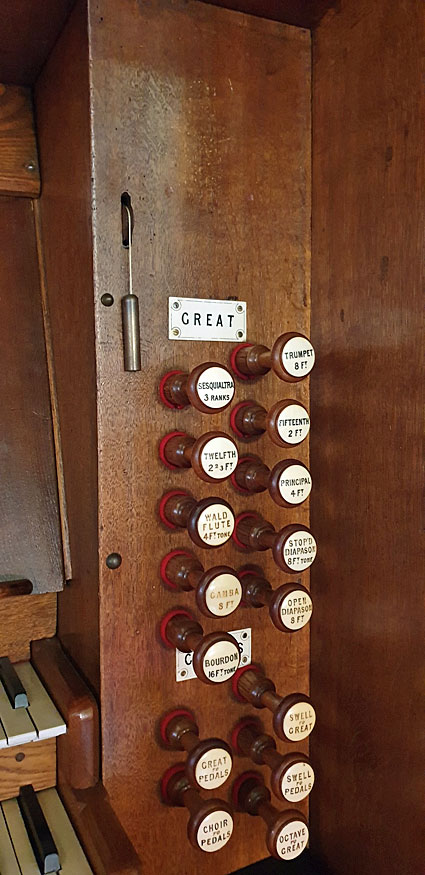
St Stephen's Church, Richmond - restored right hand stop jamb and tell-tale
(photograph by Ian Wakeley [November 2019])
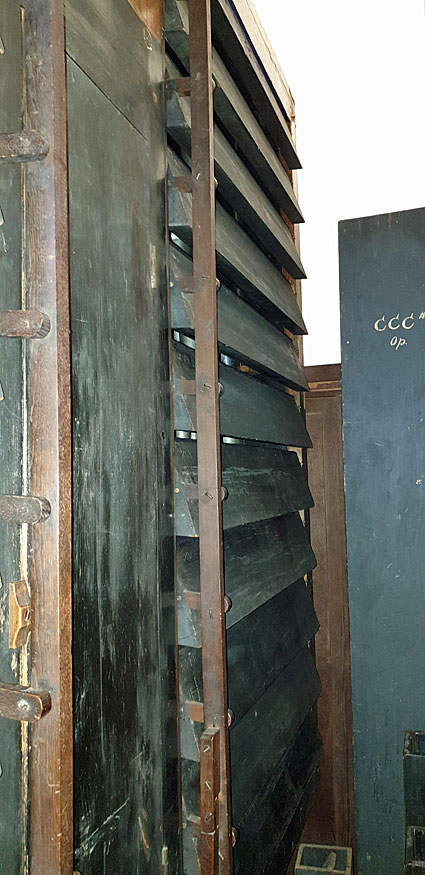
St Stephen's Church, Richmond – swell shutters
(photograph by Ian Wakeley [November 2019])
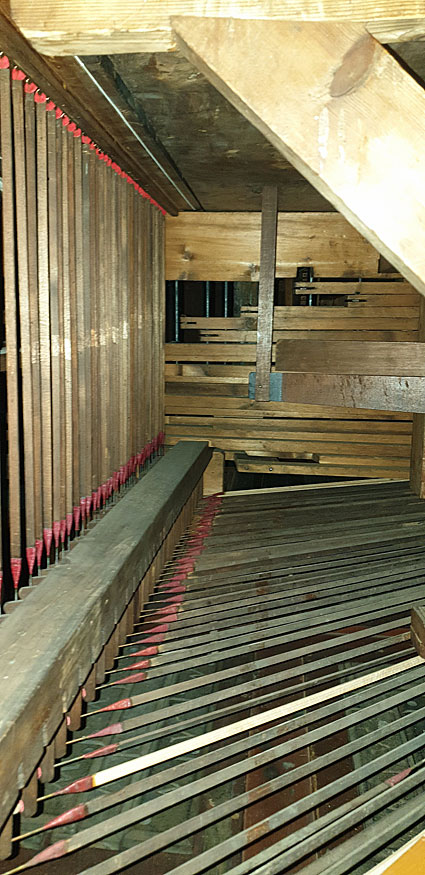
St Stephen's Church, Richmond - restored Choir diagonal action run
(photograph by Ian Wakeley [November 2019])
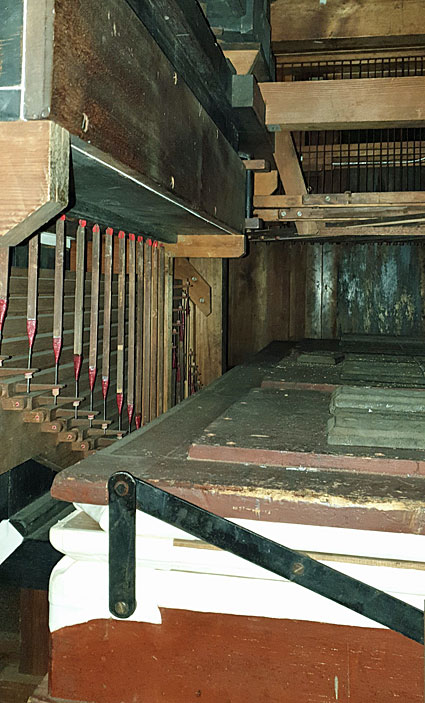
St Stephen's Church, Richmond – C side Pedal action and reservoir
(photograph by Ian Wakeley [November 2019])
PRE-RESTORATION IMAGES
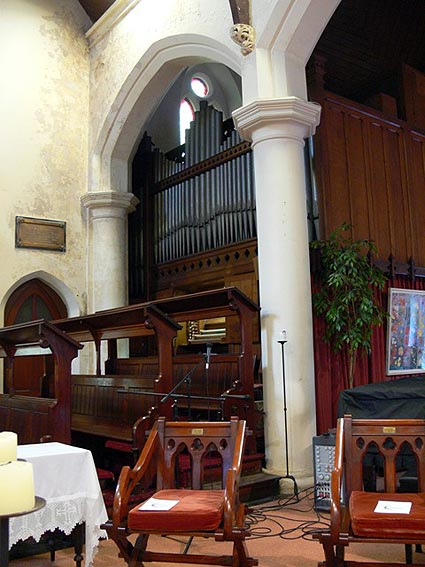 St Stephen's Anglican Church, Richmond: organ from the west with choir stalls (since removed) [photograph by John Maidment (13 April 2006)] |
|
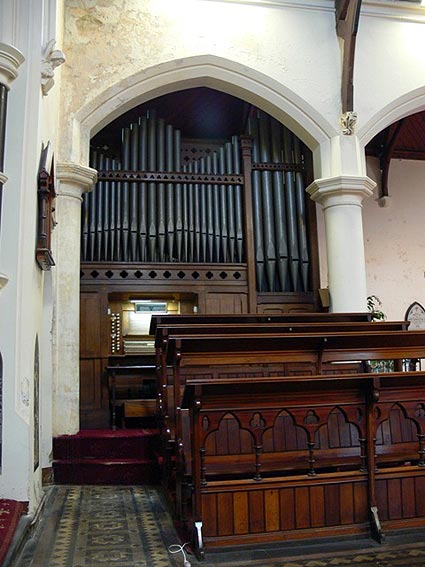 St Stephen's Anglican Church, Richmond: organ viewed across chancel [photograph by John Maidment (13 April 2006)] |
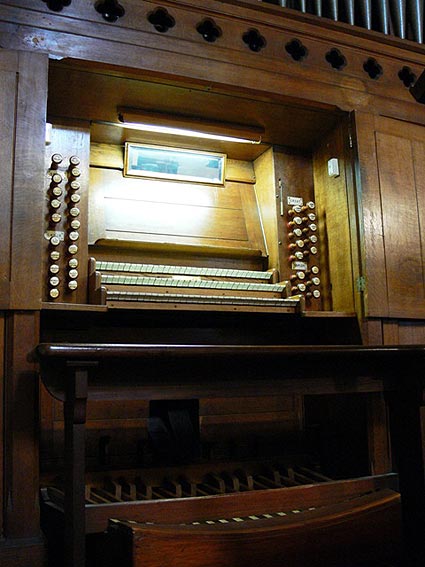 St Stephen's Anglican Church, Richmond: console [photograph by John Maidment (13 April 2006)] |
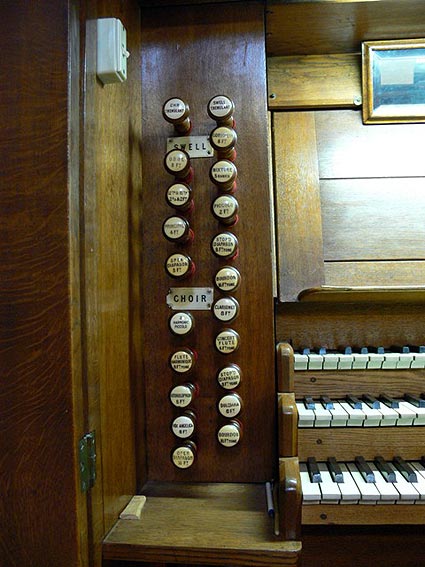 St Stephen's Anglican Church, Richmond: left-hand stop jamb [photograph by John Maidment (13 April 2006)] |
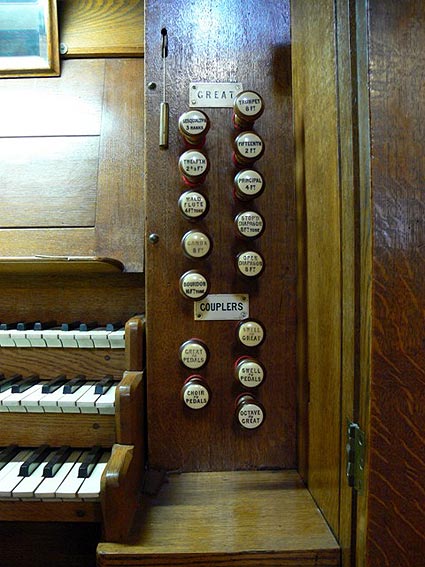 St Stephen's Anglican Church, Richmond: right-hand stop jamb [photograph by John Maidment (13 April 2006)] |
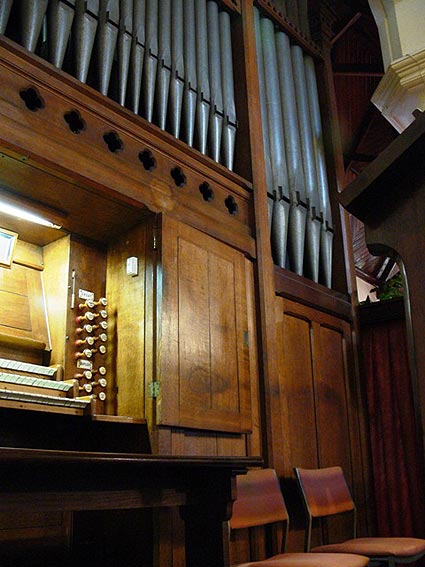 St Stephen's Anglican Church, Richmond: console and casework [photograph by John Maidment (13 April 2006)] |
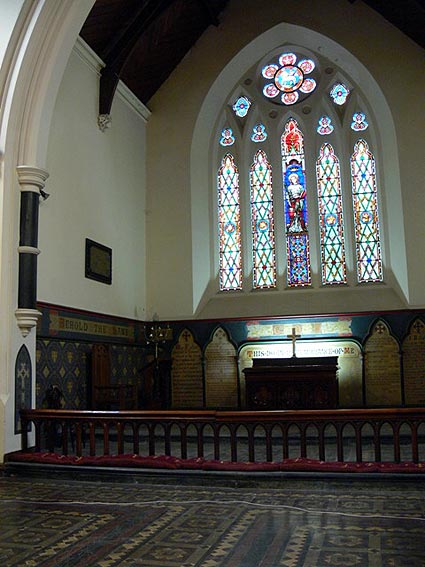 St Stephen's Anglican Church, Richmond: chancel [photograph by John Maidment (13 April 2006)] |
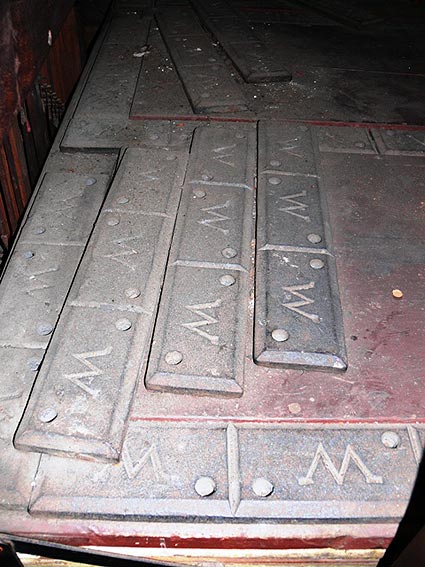 St Stephen's Anglican Church, Richmond: Walker cast iron bellows weights [photograph by John Maidment (13 April 2006)] |
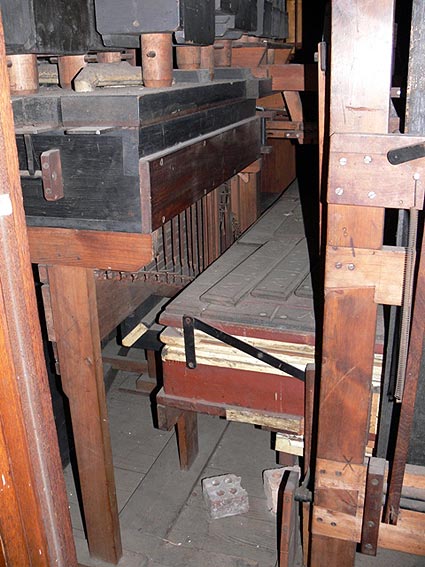 St Stephen's Anglican Church, Richmond: Double-rise reservoir and pedal C windchest [photograph by John Maidment (13 April 2006)] |
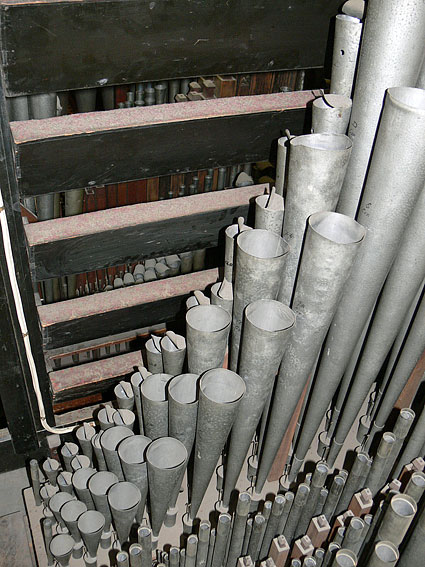 St Stephen's Anglican Church, Richmond: Swell reeds looking through Swell shutters to the Great [photograph by John Maidment (8 December 2009)] |
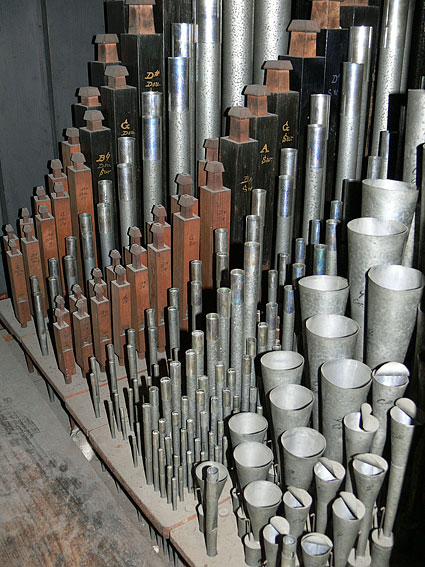 St Stephen's Anglican Church, Richmond: Swell pipework C# side [photograph by John Maidment (8 December 2009)] |
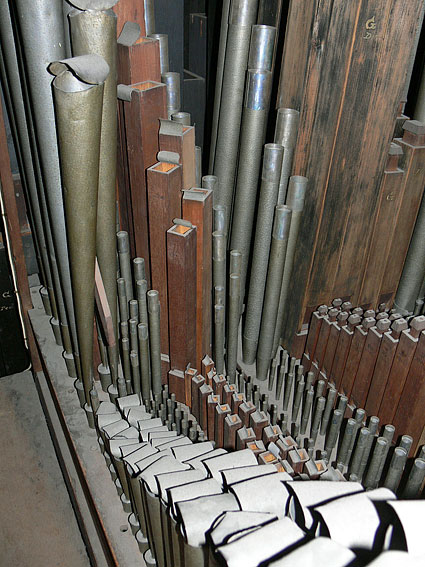 St Stephen's Anglican Church, Richmond: Great Trumpet 8ft (fitted with Fincham dust bonnets) Sesquialtra and Wald Flute 4ft [photograph by John Maidment (8 December 2009)] |
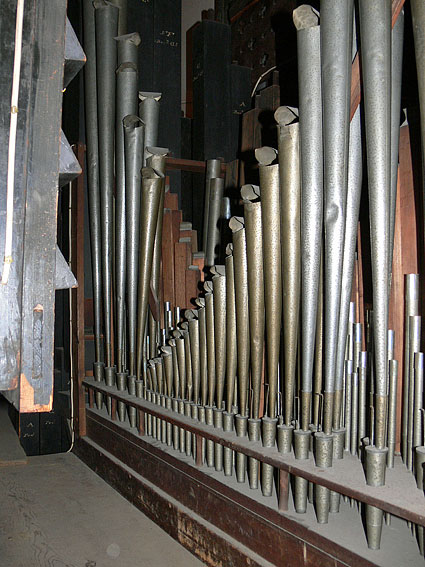 St Stephen's Anglican Church, Richmond: Great Trumpet 8ft [photograph by John Maidment (8 December 2009)] |
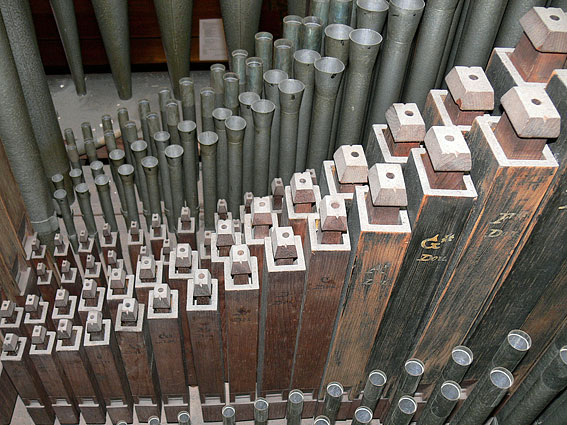
St Stephen's Anglican Church, Richmond: Great pipework showing the flared, ear-tuned Gamba 8ft and Bourdon 16ft [photograph by John Maidment (8 December 2009)] |
|
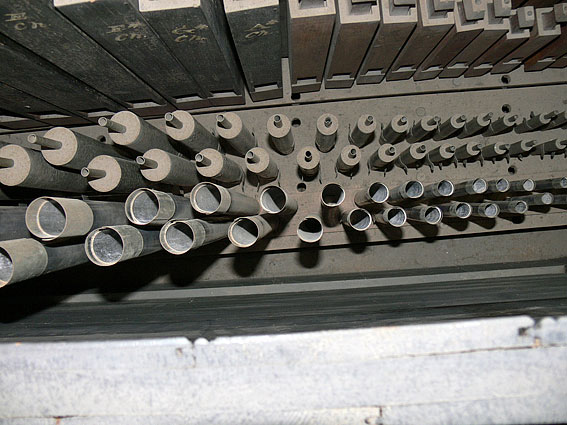
St Stephen's Anglican Church, Richmond: Choir pipework showing Concert Flute 4ft and Harmonic Piccolo 2ft [photograph by John Maidment (8 December 2009)] |
|